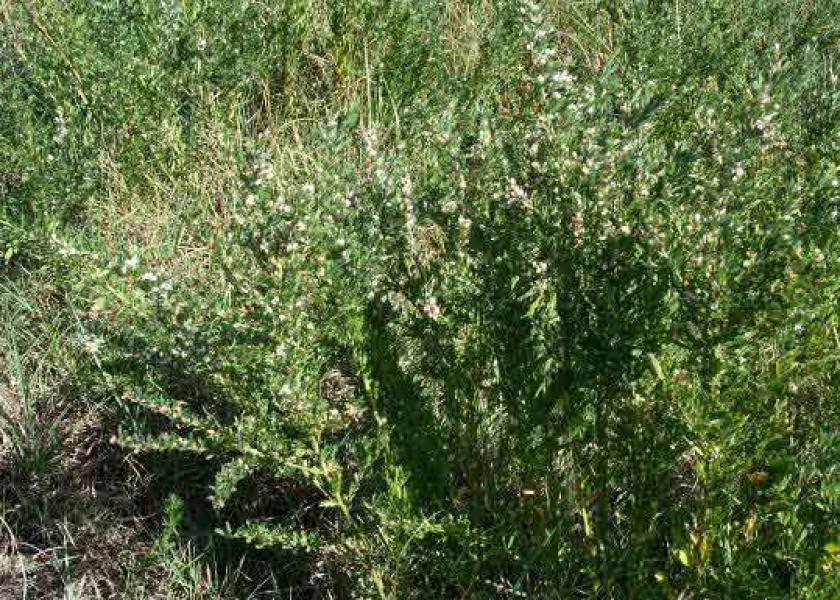Research Shows Late-Season Burning Helps Control Sericea in a Big Way

A K-State beef cattle scientist discusses a new approach to suppressing growth of a noxious weed, sericea lespedeza.
By: Katie Allen, K-State Research & Extension News
It’s a plant that tends to use many weapons to take over grasslands. Starting at the roots, this plant out-competes native plants for water and nutrients. The roots also leak allelopathic chemicals that can prevent germination of other plants.
Above the ground, the plant can produce several thousand seeds, so it is highly reproductive. And, it uses its canopy dominance to shade out and prevent native species from thriving.
The plant, sericea lespedeza, is a noxious weed that plagues many landowners in Kansas and other U.S. states. Costly herbicide applications have not effectively stopped the plant in many cases, especially when dense areas of the prairie prevent herbicides from reaching and controlling it.
KC Olson, beef cattle scientist at Kansas State University, has studied several ways to manage the growth and spread of sericea lespedeza. Cattle will graze around the plant, because it is high in tannin and therefore, unpalatable—just another reason he calls the weed a “marvel of creation.”
“As a lover of the Flint Hills, I hate that plant,” Olson said.
Olson is currently in year two of a four-year study funded by the National Fish and Wildlife Foundation to examine the effects of growing-season prescribed burning on the vigor of sericea lespedeza. Results from the first year show what Olson considers a breakthrough sericea control.
“In about a decade of working with this problem, this is probably the most promising thing I have come across,” Olson said. “We are scheduled for four years of data collection. We need to follow through, but the results from year one were so stunning we had to share them.”
When a landowner burns sericea lespedeza during the growing season, the weed will re-sprout, Olson said. The time of the burn often determines how much seed it will produce when it grows back. As part of this study, trial burns were completed in early April, followed by burns at the beginning of August and September.
“Spring-burned sericea plants produced about 350-370 seeds per plant,” Olson said. “The plants from the Aug. 1 burn produced seven seeds per plant. The plants burned Sept. 1 produced zero seeds per plant. Forage regrowth between growing season burns and the first killing frost produced at least 1 ton of forage dry matter per acre, which left what we judged to be enough residual plant material to prevent soil organic matter and moisture losses.”
Prescribed burning in September
Olson recognizes that good research supports early-spring prescribed burning in the Flint Hills. Burning in April allows stocker cattle to witness increased gains from regrowth of prairie grasses during the summer, before these cattle move to the feedlot in the late summer or early fall.
“We thought if we applied that prescribed burn at a time when stocker cattle have normally moved off the Flint Hills and into another segment of the beef production chain, we might give our producers another tool to handle (sericea lespedeza),” Olson said.
About the beginning of August, sericea lespedeza is just starting to flower, and the beginning of September is when the seedpods start to set, he explained.
“We thought stress on sericea at those times would cut into seed production,” Olson said. “We believe that’s a key to control. We also think plants that belong (in the Flint Hills) are not going to be disturbed by late fire timing.”
“We know research at the Konza Prairie—applying fire in every month of the year—did not observe any compositional shifts,” he continued. “Granted, that is without the presence of the livestock, but it’s enough information to move forward, take some risks and see if we can do some good for the state.”
In the first year of the study, Olson said he also noticed a hit in other woody species the following spring, including smooth sumac, dogwood, eastern red cedar, honey locust and other undesirables that spring burning typically helps eliminate.
If the data continues to show that landowners can control sericea lespedeza substantially through late-season burns, he said intensive early-stocking systems could see benefit in using the practice.
“I can envision a scenario where a producer who has a big problem with sericea lespedeza burns after the steers leave rather than before the steers come,” Olson said. “I anticipate there will be some sacrifice in performance. Burning costs about 75 cents per acre. Chemical is substantially greater than that. I hear estimates of $8 to $16 per acre. We can probably accept slightly lower steer performance if we can save $15 an acre in chemical cost.”
Results from year one will be presented in June at the 2015 Western Section Meeting of the American Society of Animal Science.







